Magnificence at Yale, Part Three
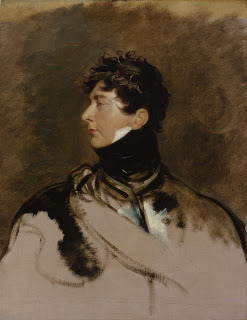 I decided to do a separate blog about what I will call the POWER portraits of the exhibition now at the Yale Center for British Art in New Haven CT. It will be on view until June 5, 2011, the second and last venue, so if you can possibly make it there, you will be richly rewarded. Part two, posted on 3/12/11, could have been called BRILLIANCE. What poured out of me in the 3/8/11 post covered the things that caught my eye first off. You see, a perfectly rational way to divide up the spoils of this excellent exhibition....
I decided to do a separate blog about what I will call the POWER portraits of the exhibition now at the Yale Center for British Art in New Haven CT. It will be on view until June 5, 2011, the second and last venue, so if you can possibly make it there, you will be richly rewarded. Part two, posted on 3/12/11, could have been called BRILLIANCE. What poured out of me in the 3/8/11 post covered the things that caught my eye first off. You see, a perfectly rational way to divide up the spoils of this excellent exhibition.... To the right is Lawrence's view of Prince George as Prince Regent, painted about 1814. George was florid, overweight, dissolute, and flabby, but not in this view, one of the most egregious of Lawrence's flatteries. It is in London's National Portrait Gallery; some observers say that it is unfinished because it was a study for a coin or a medal, a project which never came to fruition. I'll bet George loved it, for he looks young and vital.
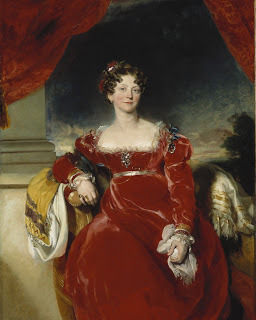
George's sister, Princess Sophia (1777-1848) was never married, though it is generally accepted that she had a child out of wedlock. The father may have been her father's equerry, Thomas Garth. Others, perhaps with political motives, said the father of her child was her brother the Duke of Cumberland.
As one of the six daughters of King George III and Queen Charlotte, Princess Sophia's life was constrained by the demands of her parents and court life. She could not see much of her lover, whoever he was. Not a life I would wish on anyone. In this brilliant red dress, at age 48, I can almost feel her flirting with Lawrence as she sat for him. He was quite the ladies' man, having had many flirtations with princesses, actresses, titled married ladies and others, but none of his relationships grew into marriage. On the other hand, he also was very close to some of his male sitters, leading to occasional suspicions in another direction. For more on his love life,see Jo Manning's posts here on January 8, 9, and 10, 2011.
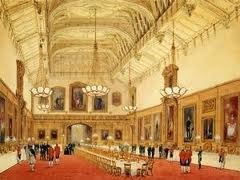
The Prince Regent knighted Sir Thomas Lawrence in 1815, about the same time as he commissioned the artist to travel around Europe and paint grand portraits of the victorious allied leaders in the war against Napoleon. Certainly this was one of the greatest royal commissions for one artist, and the result was suitably magnificent. Several of the paintings below were shown only at the London venue of this exhibition, but since I had seen them in situ at the Waterloo Chamber in Windsor Castle just last summer, I could forgive the Royal Collections for having kept them on their side of the pond. Above, the Waterloo Chamber painted by Joseph Nash in 1844.
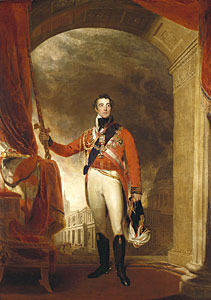
In the upper center of the far wall is this painting of the Duke of Wellington who led the allied troops in the Battle of Waterloo, June 18, 1815. This painting is not in the exhibition, but it has been reproduced so often that it is bound to be familiar. Like the watercolor of the chamber, above, and most of the other heroes below, it belongs to Her Majesty Queen Elizabeth II.
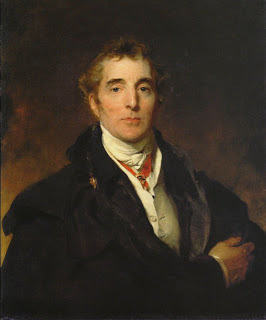
This is the portrait of the Duke to be seen in the New Haven exhibition. I must say I had to drag Diane Gaston away from him; she was sure he was about to speak to her.
This portrait, part of a private collection, was painted in 1820-21, and according to the catalogue, engraved more than any other of Lawrence's works of Wellington. It was commissioned by the Duke's close friends, Charles and Harriet Arbuthnot. Mrs. A is quoted in the catalogue: "It is more like him than any picture I ever saw of him and quite different. All other pictures of him depict him as a hero; this has all the softness and sweetness of countenance which characterises him when he is in the private society of his friends. As a painting, it appears to me : the tone of coloring is so rich. The cloak is just as the Duke wears it, and the hand is remarkably like."
Three of the portraits from the Waterloo Chamber were hung in the London venue of Thomas Lawrence: Regency Power and Brilliance. You will not find them at Yale, but there are several Yale portraits that were not in London, just in case you were wondering.
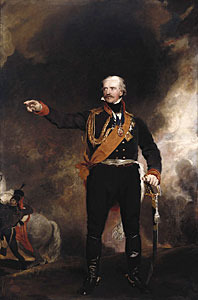 Field Marshal Gebhardt von Blucher (1742-1819) commanded the Prussian forces that cinched the Allied victory at Waterloo. He was a courageous and forceful officer
Field Marshal Gebhardt von Blucher (1742-1819) commanded the Prussian forces that cinched the Allied victory at Waterloo. He was a courageous and forceful officer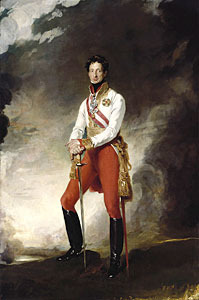 Charles, Archduke of Austria (1771-1847) was painted in 1819 in Vienna. He led the Austrian armies in many battles in which he proved his abilities as a strategist, though he both won and lost against Napoleon during his army career. He was also a distinguished patron of the arts, and Lawrence reportedly enjoyed his companionship.
Charles, Archduke of Austria (1771-1847) was painted in 1819 in Vienna. He led the Austrian armies in many battles in which he proved his abilities as a strategist, though he both won and lost against Napoleon during his army career. He was also a distinguished patron of the arts, and Lawrence reportedly enjoyed his companionship.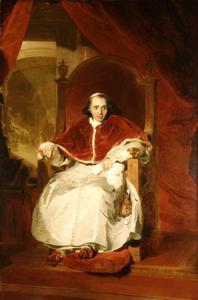 Lawrence made his first visit to Rome in 1819 to paint Pope Pius VII (1742-1823). This is often admired as the finest portrayal of the Waterloo portraits, an particular achievement, says the catalogue, when one thinks of the brilliant artists who portrayed popes in the past. Names such as Raphael, Velazquez, Michelangelo, David and many others must have been in Lawrence's mind as he worked.
Lawrence made his first visit to Rome in 1819 to paint Pope Pius VII (1742-1823). This is often admired as the finest portrayal of the Waterloo portraits, an particular achievement, says the catalogue, when one thinks of the brilliant artists who portrayed popes in the past. Names such as Raphael, Velazquez, Michelangelo, David and many others must have been in Lawrence's mind as he worked.A close examination of the portrait reveals the word PAX on the pope's throne and classical statues from the Vatican collection in the background.
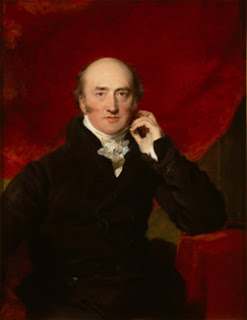 Throughout his career, Lawrence was called on to paint many political leaders of all persuasions in England. We have already seen Lord Liverpool in my post of 3/8/11. And many of his portraits were of business leaders or scientific personages -- but he certainly had more than his share of parliamentary leaders and party spokesmen sitting for him. At right is George Canning (1770-1827), in a portrait completed in 1822 when he was Foreign Secretary. He served briefly as Prime Minster in 1827 and died in office.
Throughout his career, Lawrence was called on to paint many political leaders of all persuasions in England. We have already seen Lord Liverpool in my post of 3/8/11. And many of his portraits were of business leaders or scientific personages -- but he certainly had more than his share of parliamentary leaders and party spokesmen sitting for him. At right is George Canning (1770-1827), in a portrait completed in 1822 when he was Foreign Secretary. He served briefly as Prime Minster in 1827 and died in office.In September, 1809, when Canning was Foreign Secretary, he and Lord Castlereagh disagreed so violently over the disastrous Walcheren Expedition that they fought a duel on Putney Heath. Neither waas injured. As Foreign Secretary from 1812 to 1821, Lord Castlereagh represented Britain at the Congress of Vienna and was painted by Lawrence himself. After Castlereagh, who had inherited the title of 2nd Marquess of Londonderry by then, committed suicide in 1821, Canning succeeded him as Foreign Secretary again. The Londonderry title went to Castlereagh's half-brother, Charles William (Vane-) Stewart, later 3rd Marquess of Londonderry, whose portrait by Lawrence is in this exhibition (see post of 3/12/11).
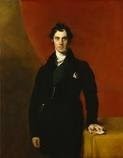 George Hamilton-Gordon, 4th Earl of Aberdeen (1784–1860), is the subject of one of Lawrence's last portraits. He was Prime Minister from 1852 to 1855. The catalogue says the portrait, partly unfinished, "won widespread praise" when it was exhibited after Lawrence's death. Painted in 1829-30, it seems to foreshadow the future success of Lord Aberdeen.
George Hamilton-Gordon, 4th Earl of Aberdeen (1784–1860), is the subject of one of Lawrence's last portraits. He was Prime Minister from 1852 to 1855. The catalogue says the portrait, partly unfinished, "won widespread praise" when it was exhibited after Lawrence's death. Painted in 1829-30, it seems to foreshadow the future success of Lord Aberdeen. After a brief illness, Lawrence died on 7 January, 1830. His body lay in state at the Royal Academy before his funeral at St. Paul's Cathedral, where he is buried in the crypt. Below, a watercolor of the funeral by J. M. W. Turner, 1830, belonging to the Tate Britain (not in the exhibition).
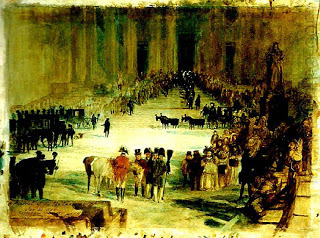
This is the third of my posts on Thomas Lawrence Regency Power and Brilliance, at the Yale Center for British Art in New Haven, CT. It will be on display until June 5, 2011. Soon we will have other posts on our jaunt to Yale. I wish everyone who visits Number One London could have come along. Thanks again to all the wonderful people at Yale, especially Kaci Bayliss and Amy McDonald.
Published on March 16, 2011 02:00
No comments have been added yet.
Kristine Hughes's Blog
- Kristine Hughes's profile
- 6 followers
Kristine Hughes isn't a Goodreads Author
(yet),
but they
do have a blog,
so here are some recent posts imported from
their feed.



